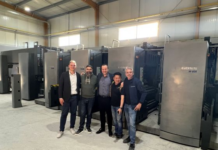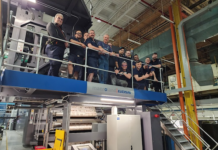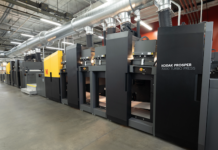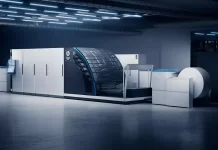The revolutionary Goss Sunday web press technology turns 20 this month. Two decades and 2300 Sunday press printing units later, Goss technology has had a worldwide impact on productivity, profitability and the overall competitiveness of printed products.
While prior offset innovations were incremental, the original Sunday 3000 press model instantly gave printers a way to nearly double output capacity while improving print quality and reducing paper waste. Several R&D breakthroughs enabled this substantial leap forward, but none were as vital as the gapless blanket that has come to define Sunday press technology.
Flat blankets on a conventional offset press are wrapped around the blanket cylinder, and the two ends are secured in a narrow channel, or gap, in the cylinder. Flexural vibration, occurring when opposing gaps meet, forces a trade-off between press speed, web width and print quality and puts limitations on all three.
Replacing the flat blankets with cylindrical Sunday press blankets that slide over the blanket cylinders from the sides eliminated this gap related vibration. This allowed the original Sunday 3000 press to print at up to 100000 impressions per hour instead of the 75000 impressions per hour that web printers were previously accustomed to. At the same time, the dynamic stability also allowed single-circumference web widths to be extended from the traditional four magazine pages across the cylinder to six pages and eventually eight pages across the cylinder. Goss Sunday 4000 press models soon provided corresponding speed and width advantages in the double-circumference format.
Reduced vibration meant no streaking and better print quality, even at the higher speeds. Gapless blankets also reduced the non-print area, allowing shorter cut-offs and paper savings of up to 6.4 mm (0.25 inch) with every cylinder revolution or more than 250 paper rolls per year in a typical commercial web printing operation.
As with any revolutionary innovation, engineering challenges in developing the Sunday press were considerable. The Sunday technology R&D team was in unchartered waters with the speeds they were attempting on their test press in the early 1990s. Mechanical hurdles arose, but their fundamental concepts worked and were promising from the start. The reaction from customers consulted in those early days, on the other hand, ranged from cautious optimism to complete doubt. As the gapless Sunday press concept became public in early 1992, one competitor called it the “Someday” press, implying that a production model was many years from completion.
Almost immediately, however, the Sunday 3000 press established itself as the leading choice for single-circumference catalogue and publication printing. Sunday technology earned the prestigious InterTech Award in 1994. A year later a Sunday Press wowed audiences at drupa. By the end of 1995, 31 gapless Sunday press systems had been installed in six countries.
The 1993 introduction of gapless-blanket technology pushed the Sunday press into a league of its own, but Goss International has not rested on its laurels. New models for new applications have been introduced continuously, as have key technologies to enable or amplify the basic advantages of the gapless concept. These include Autoplate, Automatic Transfer, pinless folding and DigiRail digital inking technologies as well as automated controls and high-performance splicers, dryers and auxiliaries. As a result, Sunday presses continue to deliver the ultimate in web offset productivity, print quality and efficiency, with printers in 27 countries relying on them for publications, catalogues direct marketing, retail inserts, packaging and other specialised products.
Meanwhile, the very first press still remains in operation in the United States, adding durability to the long list of Sunday press advantages.
Sunday Press Milestones
1986 – Engineers and executives commit to pursuing revolutionary gapless web press technology at meetings during the weekend of the American football “Superbowl Sunday”, giving the top-secret project the code name Sunday Press.
1987 – Customer focus panels and market research.
1989 – Construction of R&D laboratory in New Hampshire (USA) to house first Sunday press.
December 1990 – First live print test of gapless Sunday press.
March 1991 – Test press printed at record breaking speed of 15 meters per second (3,000 feet per minute).
December 1992 – First Sunday press shipped to commercial web printer in the United States.
1994 – Sunday press earns InterTech award for gapless-blanket technology.
June 1995 – Sunday 3000 press in operation at drupa show.
September 1998 – Introduction of Sunday 4000 double-circumference models.
1999 – Introduction of Sunday 2000 model for high-quality, short- and medium-run commercial printing and Sunday press Autoplate automatic plate changing technology earns InterTech Award.
May 2000 – Mainstream – world’s first gapless newspaper press – in full operation at drupa show.
September 2003 – Sunday 3000/32 – world’s first press with 2×8 page cylinder configuration – shipped to Thijsen Printing (Netherlands).
2005 – Sunday press Automatic Transfer technology for continuous printing earns InterTech Award.
January 2009 – First Sunday press with DigiRail digital inking in production at Quad/Graphics (USA).
May 2009 – Sunday 5000 – world’s first 96-page web press – in production at Grafiche Mazzucchelli (Italy).
October 2012 – World’s first Sunday Vpak packaging press with variable repeat shipped to Precision Press (USA).





















